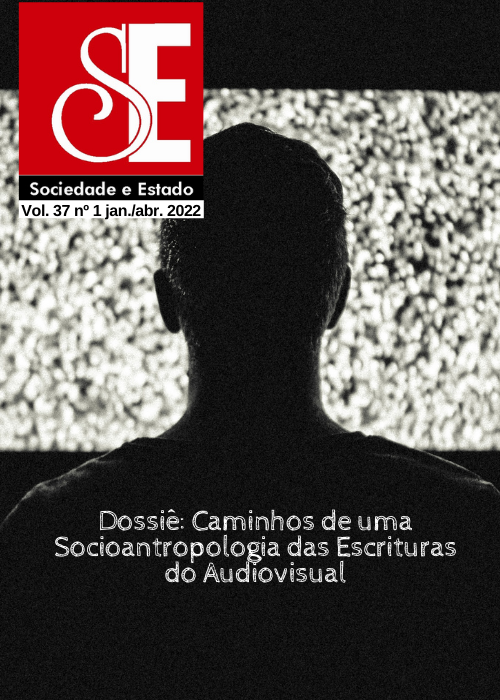Affects and meanings in the film Swirl (2011), by Clarissa Campolina and Helvécio Marins
DOI:
https://doi.org/10.1590/s0102-6992-202237010003Keywords:
Experience. Sensitive. Image. Film. ThoughtAbstract
The main objective of this essay is to analyze the film Swirl (2011), by Clarissa Campolina and Helvécio Marins, as an experience in itself. The film is analyzed in dialogue with recent film analyzes that relate affect and language. The focus is on the film’s script, as well as on its light, sound, color, shot, camera movements, and montage. The analytical effort mobilizes a bibliography connected to philosophy, sociology, studies of affect, film, and literature. The analysis shows that the film is a sensitive experience that affects the spectator/analyst through a work with cinematographic language that instigates both the attentive reading and the creation of meanings.
Downloads
References
AGAMBEN, Giorgio. O que é o contemporâneo? E outros ensaios. Chapecó, SC: Argos, 2009.
AHERN, Stephen. Introduction: a fell for the text. In: ______. Affect theory and literary critical practice: a feel for the text. Wolfville, CA: Acadia University, 2019.
BENJAMIN, Walter. Passagens. Belo Horizonte: Editora UFMG, 2009.
______. Pequena história da fotografia. In: ______. Obras escolhidas, v. 1. “Magia e técnica, arte e política. Ensaios sobre literatura e história da cultura”. São Paulo: Brasiliense, 1987.
______. A obra de arte na época de suas técnicas de reprodução. In: GRÜNNEWALD, José. A ideia do cinema, p. 55-95. Rio de Janeiro: Civilização Brasileira, 1969.
BRINKEMA, Eugenie. The form of the affects. Durham, NC: Duke University Press, 2014.
BUCK-MORSS, Susan. Estética e anestética: uma reconsideração de A obra de arte de Walter Benjamin. In: CAPISTRANO, Tadeu (Org.). Benjamin e a obra de arte: técnica, imagem, percepção, p. 155-204. Rio de Janeiro: Contraponto, 2012.
COUTINHO, Eduardo F. La desconstrucción de la mirada dicotómica en Grande sertão veredas. Cuadernos Literarios, v. 1, n. 2, p. 49-58, 2003. Disponível em: <https://ucss.edu.pe/images/fondo-editorial/revista-cuadernos-literarios-02/desconstruccion-mirada-dicotonica-eduardo-coutinho.pdf>. Acesso em: 06 Mar. 2022.
CLOUGH, Patricia. Introduction. In: CLOUGH, Patricia; HALLEY, J. (Orgs.). The affective turn: theorizing the social, p. 1-33. Durham, NC: Duke University Press, 2007.
COHN, Gabriel. Weber. Sociologia. 7. ed. São Paulo: Ática, 2008.
DELEUZE, Gilles; GUATTARI, Félix. Cinema II: a imagem-tempo. São Paulo: Brasiliense, 2013.
______. O que é a filosofia? São Paulo: Editora 34, 2007.
GREGG, Melissa; SEIGWORTH, Gregory. An inventory of shimmers. In: ______. The affect theory reader, p. 1-28. Durham, NC: Duke University Press, 2010.
HANSEN, Miriam. Benjamin, cinema e experiência: a flor azul na terra da tecnologia. In: BENJAMIN, Walter [et al.]. Benjamin e a obra de arte: técnica, imagem, percepção, p. 205-255. Organização de Tadeu Capistrano. Rio de Janeiro: Contraponto, 2012.
HARDT, Michael. Foreword: what affects are good for. In: CLOUCH, Patrícia. Affect turn: theorizing the social, p. iv-xiii. Durham, NC: Duke University, 2007.
INOUE, Kazuo. Eu vivi, mas... Uma biografia de Yasujiro Ozu. Tokyo: IMDB, 1983.
KOLJONEN, Johanna. Nostradamus Report: relevance in a new reality. Göteborg, SE: Göteborg Film Festival, 2019. Disponível em: <https://www.efm-berlinale.de/media/pdf_word/efm/69_efm/horizon/reports/nostradamus2019.pdf>. Acesso em: 20 Fev. 2022.
» https://www.efm-berlinale.de/media/pdf_word/efm/69_efm/horizon/reports/nostradamus2019.pdf
LALANE, Jean-Marc. Que plano é esse? Cahiers du cinéma, n. 569, Jun. 2002. Disponível em: <https://view.officeapps.live.com/op/view.aspx?src=http%3A%2F%2Fwww.geocities.ws%2Fruygardnier%2Flalannequeplanoeesse.doc&wdOrigin=BROWSELINK>. Acesso em: 06 Mar. 2022.
MARTIN, Marcel. A linguagem cinematográfica. São Paulo: Brasiliense, 2013.
MASSUMI, Brian. Parables for the virtual: movement, affect, sensation. Durham, NC; Duke University Press, 2002.
MERLEAU-PONTY, Maurice. A linguagem indireta e as vozes do silêncio. “Signos”. São Paulo: Martins Fontes, 1991 [1960].
ROSA, João Guimarães. Grande sertão: veredas. São Paulo: Companhia das Letras, 2019 [1956].
SHAVIRO, Steve. The cinematic body redux, 2008. Disponível em: <http://www.shaviro.com/Othertexts/Cinematic.pdf>
» http://www.shaviro.com/Othertexts/Cinematic.pdf
______. The cinematic body. Minnesota, MN: University of Minnesota Press, 1993.
SPINOZA, Baruch. Ética. Belo Horizonte: Autêntica, 2009.
WEBER, Max. A ciência como vocação: In: ______. Três tipos de poder e outros escritos. Lisboa: Tribuna da História, 2005.
XAVIER, Ismail. A experiência do cinema. São Paulo: Paz e Terra, 2018.
______. O discurso cinematográfico: a opacidade e a transparência. 3. ed. São Paulo: Paz e terra, 2005.
Downloads
Published
How to Cite
Issue
Section
License
Copyright (c) 2022 Sociedade e Estado

This work is licensed under a Creative Commons Attribution-NonCommercial 4.0 International License.




.jpg)



















